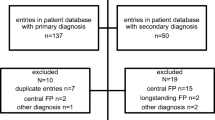Abstract
Reactivation of latent herpes simplex virus (HSV) type I or varicella-zoster virus (VZV) has been recognized as the most common pathomechanism underlying Bell’s palsy. There is also increased reactivation of HSV or VZV in patients with immunosuppressed states and in cancer patients. The purpose of this study was to investigate the risk for cancer during a 5-year follow-up period after diagnosis of Bell’s palsy by using a population-based dataset in Taiwan. We used data from the “Longitudinal Health Insurance Database”. We identified 2,618 patients with Bell’s palsy as the study cohort and randomly selected 13,090 patients to be used as a comparison cohort. Cox proportional hazards regression was performed to compare the 5-year risk of subsequent cancer between the study and comparison cohorts. We found that the incidence of cancer was 1.55 (95 % CI 1.35–1.78) per 100 person-years for patients with Bell’s palsy and 1.09 (95 % CI 1.02–1.18) per 100 person-years for comparison patients. After censoring cases that died from non-cancer causes during the follow-up period and adjusting for urbanization, monthly income, geographic region, and diabetes, the hazard ratio (HR) for cancer during the 5-year follow-up period for patients with Bell’s palsy was 1.43 times that for comparison patients (95 % CI 1.22–1.73). There was a particularly increased risk of oral cancer (HR = 2.49; 95 % CI 1.54–4.03) for patients with Bell’s palsy compared with the other patients. We conclude that patients with Bell’s palsy were at significant risk of cancer during a 5-year follow-up period after diagnosis.

Similar content being viewed by others
References
Adour KK, Byl FM, Hilsinger RL Jr, Kahn ZM, Sheldon MI (1978) The true nature of Bell’s palsy: analysis of 1,000 consecutive patients. Laryngoscope 88:787–801
Pecket P, Schattner A (1982) Concurrent Bell’s palsy and diabetes mellitus: a diabetic mononeuropathy? J Neurol Neurosurg Psychiatr 45:652–655
Yanagihara N, Hyodo M (1988) Association of diabetes mellitus and hypertension with Bell’s palsy and Ramsay Hunt syndrome. Ann Otol Rhinol Laryngol Suppl 137:5–7
Shmorgun D, Chan WS, Ray JG (2002) Association between Bell’s palsy in pregnancy and pre-eclampsia. QJM 95:359–362
Calcaterra TC, Rand RW, Bentson JR (1976) Ischemic paralysis of the facial nerve: a possible etiologic factor in Bell’s palsy. Laryngoscope 86:92–97
Thomsen J, Barfoed C (1979) Idiopathic facial palsy. Viral, hereditary, or both? Arch Otorhinolaryngol 222:109–112
Mañós-Pujol M, Buendia E, Mestre M, Jimenéz R, Gil E, Menén JP et al (1987) Cellular immunity abnormalities in patients with recurrent Bell’s palsy. Clin Otolaryngol Allied Sci 12:283–287
Morgan M, Moffat M, Ritchie L, Collacott I, Brown T (1995) Is Bell’s palsy a reactivation of varicella zoster virus? J Infect 30:29–36
Holland NJ, Weiner GM (2004) Recent developments in Bell’s palsy. BMJ 329:553–557
Tiemstra JD, Khatkhate N (2007) Bell’s palsy: diagnosis and management. Am Fam Phys 76:997–1002
Dolin R, Reichman RC, Mazur MH, Whitley RJ (1978) Herpes zoster-varicella infections in immunosuppressed patients. Ann Intern Med 89:375–388
Epstein JB, Scully C (1991) Herpes simplex virus in immunocompromised patients: growing evidence of drug resistance. Oral Surg Oral Med Oral Pathol 72:47–50
Rusthoven JJ, Ahlgren P, Elhakim T, Pinfold P, Reid J, Stewart L et al (1988) Varicella-zoster infection in adult cancer patients. A population study. Arch Intern Med 148:1561–1566
Djuric M, Jankovic L, Jovanovic T (2009) Prevalence of oral herpes simplex virus reactivation in cancer patients: a comparison of different techniques of viral detection. J Oral Pathol Med 38:167–173
Boahene DO, Olsen KD, Driscoll C, Lewis JE, McDonald TJ (2004) Facial nerve paralysis secondary to occult malignant neoplasms. Otolaryngol Head Neck Surg 130:459–465
Quesnel AM, Lindsay RW, Hadlock TA (2010) When the bell tolls on Bell’s palsy: finding occult malignancy in acute-onset facial paralysis. Am J Otolaryngol 31:339–342
Lin HC, Chao PZ, Lee HC (2008) Sudden sensorineural hearing loss increases the risk of stroke: a 5-year follow-up study. Stroke 39:2744–2748
American Cancer Society (2012) Cancer facts & figures 2012. American Cancer Society, Atlanta
Smyth MJ, Dunn GP, Schreiber RD (2006) Cancer immunosurveillance and immunoediting: the roles of immunity in suppressing tumor development and shaping tumor immunogenicity. Adv Immunol 90:1–50
Steiner I, Kennedy PG, Pachner AR (2007) The neurotropic herpes viruses: herpes simplex and varicella-zoster. Lancet Neurol 6:1015–1028
Sarid R, Olsen SJ, Moore PS (1999) Kaposi’s sarcoma-associated herpesvirus: epidemiology, virology, and molecular biology. Adv Virus Res 52:139–232
Pattle SB, Farrell PJ (2006) The role of Epstein–Barr virus in cancer. Expert Opin Biol Ther 6:1193–1205
Fung J, Lai CL, Yuen MF (2009) Hepatitis B and C virus-related carcinogenesis. Clin Microbiol Infect 15:964–970
zur Hausen H (1991) Viruses in human cancers. Science 254:1167–1173
Shacter E, Weitzman SA (2002) Chronic inflammation and cancer. Oncology (Williston Park) 16:217–226
Saha A, Kaul R, Murakami M, Robertson ES (2010) Tumor viruses and cancer biology: modulating signaling pathways for therapeutic intervention. Cancer Biol Ther 10:961–978
Chung SD, Kang JH, Liao CH, Chiu KM, Lin HC (2011) Increased risk for cancer following erectile dysfunction: a nationwide population-based follow-up study. J Sex Med 8:1513–1520
Ho JD, Xirasagar S, Lin HC (2011) Increased risk of a cancer diagnosis after herpes zoster ophthalmicus: a nationwide population-based study. Ophthalmology 118:1076–1081
Chiu YN, Yen MF, Chen LS, Pan SL (2012) Increased risk of stroke after Bell’s palsy: a population-based longitudinal follow-up study. J Neurol Neurosurg Psychiatr 83:341–343
Acknowledgments
This study is based in part on data from the National Health Insurance Research Database provided by the Bureau of National Health Insurance, Department of Health, Taiwan, and managed by the National Health Research Institutes. The interpretations and conclusions contained herein do not represent those of the Bureau of National Health Insurance, Department of Health, or the National Health Research Institutes.
Conflict of interest
All authors have no conflicts of interest to declare.
Author information
Authors and Affiliations
Corresponding author
Rights and permissions
About this article
Cite this article
Sheu, JJ., Keller, J.J. & Lin, HC. Increased risk of cancer after Bell’s palsy: a 5-year follow-up study. J Neurooncol 110, 215–220 (2012). https://doi.org/10.1007/s11060-012-0954-9
Received:
Accepted:
Published:
Issue Date:
DOI: https://doi.org/10.1007/s11060-012-0954-9




